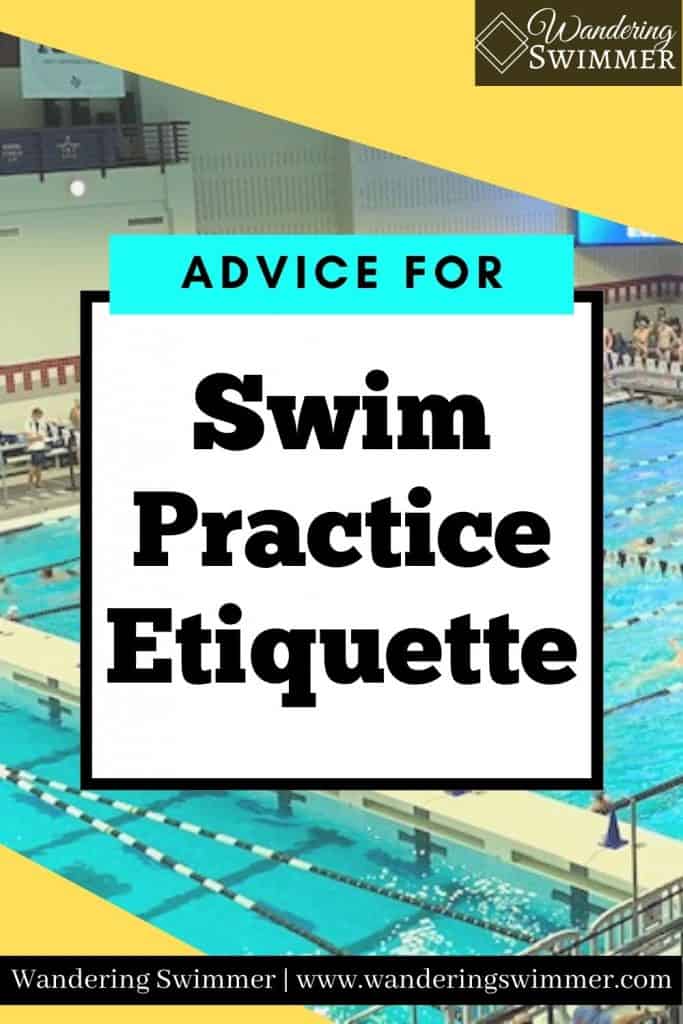Every swim team has practice etiquette that they follow. Both in the pool and dryland. While some of these unspoken rules vary by team, some are the same across teams as a whole.
Related Article: 30 Words to Get You by at Swim Practice
If you’re new to a swim team, we’ve compiled some basic swim practice etiquette to help get you started.
Disclosure: This post may contain affiliate links, meaning we earn a small commission at no cost to you if you purchase something through one of our links. As an Amazon Associate, we earn from qualifying purchases. Please check out our disclosure page for more information.

- Best Swim Practice Etiquette
- Be at Practice on Time
- Mind the Clock
- Pick Your Lane According to Your Speed
- Let Those Faster Than You go First
- Don’t Ride Someone’s Feet
- Use Your Own Equipment (and Water Bottle)
- Swim Practice Etiquette for COVID
- Don’t Come to Swim Practice Sick
- Brush Your Teeth
- Treat Other Swimmers With Respect
- Bonus Content:
- Want to Improve at the Pool?
Best Swim Practice Etiquette
Be at Practice on Time
It should go without saying, but show up to practice on time.
Don’t stroll onto the deck in the middle of a set or halfway through warm-up. By this point, swimmers already have a feel for the people in their lane. Adding another at the last minute is jarring and frustrating.
It’s also disrespectful to your coaches and teammates.
If you have to arrive late for whatever reason, make sure you let your coach know at best. It doesn’t hurt to mention it to your lane mates either, so they know to expect you later on.
Mind the Clock
This swim practice rule has several meanings. In swimming, the clock is used for almost everything. From taking rest to calculating time on intervals. That said, there is some swim practice etiquette regarding the clock that you should follow.
Leave 5 or 10 Seconds Apart
At swim practice, swimmers leave the wall behind each other at set times. Based on the team and the number of people in each lane, this can be either five or ten seconds.
Leaving too early or too late is a pet peeve of most swimmers. Because leaving too early means you’re on the person’s feet in front of you. And if you leave too late, the swimmers behind you have to make up the difference.
More Content for You: What to Know About Swim Practice and Dryland
Not following this simple form of swim practice etiquette can make your lane mates very disgruntled with you. Leaving early is as simple as leaving 3 seconds instead of 5 seconds.
And yes, that little bit does make a big difference.
If you’re new to a swim team or if you’re visiting another team, be sure to ask what the wait time is between swimmers.
Take Your Rest
It sounds ridiculous to say, as rest is everyone’s favorite time during a set. But some swimmers will skip their rest to finish a set quicker. Or, to catch up with other swimmers if they’re behind.
And look, we get it. It’s not fun when you’re behind on a set and you’re playing catch up.
But coaches put in rest time or give you an interval with rest built-in for a reason. When you skip your rest, it doesn’t do anything good for your training.
Know Your Interval
We’ll admit that this one isn’t always the easiest. By the time you get to the fifth or so number on a set, time sort of blurs together 😀
Part of swim practice is knowing how to read a clock for intervals. Especially if you’re leading the lane.
More Content for You: How to Prepare for Your First Swim Practice
That said, try to make an effort to know when you should leave. Don’t turn around to keep asking your lane mates when you should go. We understand that it happens occasionally and clarifying then isn’t a big deal.
But it’s still good swim practice etiquette to know your various intervals given to you.
Pick Your Lane According to Your Speed
No one likes having another swimmer run them over. Just as no one likes it when they have to pass another swimmer constantly.
That said, make sure you’re in a lane that best suits your speed and abilities. It’s not just good etiquette for swim practice, it’s also common courtesy.
While lane order can change based upon the set and each swimmer’s abilities, the swimmers in the lane usually don’t change.
More Content for You: 6 Reasons Why You Should Wear a Swim Cap
For new swimmers, it can take a few days to find the lane that best fits your abilities. But stay patient and keep an open mind. Understand that finding the best lane for you isn’t about trying to embarrass you.
It’s about ensuring that you can have the best practice available to you. And you can’t have that if someone is in your way all the time. Or if you have to stop to let the lane pass you every set.
Let Those Faster Than You go First
Have someone in your lane faster than you? Let them go first.
Every swimmer has their strengths and weaknesses. And what you excel in, someone else might struggle. Just as the reverse is true. Lane order changes all the time for this reason based upon the set.
More Content for You: What is Dryland?
Don’t be the one who assumes they’ll always go first because you’re good in a few events. While you might be good in some strokes/distances, you’re not the best in all of them.
If you know you’re bad at backstroke compared to a lane mate, let them go before you. It’s great to go first until someone is running you over because they’re faster than you. It’s not a good feeling and it only makes your teammates annoyed.
Don’t Ride Someone’s Feet
New swim terminology and practice etiquette in one! Riding someone’s feet basically means that a swimmer is tailgating the swimmer in front of them.
If you’ve ever had someone tailgate you while driving, you know how frustrating it can be.
Someone can ride feet if they left too early, if they’re not in the right lane, or if they’re lapping a swimmer. The best swim practice etiquette for passing another swimmer is to tap their feet once to let them know you’re passing.
More Content for You: 4 Ways to Prevent Swimmer’s Ear
Once you tap their feet, make your move to go around them. Don’t just hang out behind them and play the drums on their feet! That’s a sure way to make someone mad.
Use Your Own Equipment (and Water Bottle)
Don’t take someone else’s gear or equipment. It doesn’t matter if the gear belongs to the team or not. If you didn’t get the gear you needed at the start of practice, don’t take someone else’s.
Especially if it’s their personal gear and not just equipment provided by the team.
Can mistakes happen? Yes, of course. Foggy goggles make it difficult to see what you’re grabbing at times. You could pick up the wrong kickboard or buoy. If so, be sure to apologize and give it back.
This rule also applies to water bottles, too. Don’t drink from someone’s water bottle without their permission.
Swim Practice Etiquette for COVID
We covered this briefly in How Swim Teams can Train During COVID, but some items bear repeating.
To help keep yourself and others safe, be sure to follow the following rules during swim practice:
- Wear a mask when not in the water. This includes when you’re on the deck before and after practice, in the locker rooms, and the weight room
- Don’t crowd other swimmers in the lanes or on the deck
- Maintain 6 feet of social distance to help prevent the spread of COVID
- Don’t come to practice if you’ve been (or think you’ve been) exposed to COVID. Self-isolate and watch for symptoms
- Sneeze and cough into your elbow
These rules aren’t here to impede your training or stop you from training. Rather, it’s the best way to ensure your team can keep training. If too many swimmers or coaches catch COVID, the city or school could shut down your team. Or the pool.
So while it might seem like it’s a pain to follow the guidelines set forth by the CDC, USA Swimming, and others, it’s for everyone’s protection.
Don’t Come to Swim Practice Sick
On the subject of being sick.
If you’re not feeling well, please don’t come to swim practice! No one likes getting sick and catching the flu at just the right time can mess up someone’s season.
Let your coach know if you’re not feeling well and see a doctor. And don’t come back until you’re over your illness.
Brush Your Teeth
This isn’t a formal rule for swim practice, but we think it should be 🙂 But brush your teeth before coming to practice if you can. Especially morning practice. Morning breath isn’t a good smell.
And if you can brush them before going to afternoon practice, it’s a nice habit to get into. Your teammates will thank you 😉
Treat Other Swimmers With Respect
This extends not just to your teammates, but to any swimmer you share a lane with. Such as those at a swim meet.
And let’s be honest. This extends beyond your lane or your pool.
It should also extend to the pool deck, the locker and weight room, and even away from the pool itself. You wouldn’t like it if someone else treated you poorly. So be sure you don’t treat others as less.
As always, to happy swimming!
Chevron
Bonus Content:
What Should You Bring for Your First Swim Practice?: Headed to your first swim practice and not sure what you’ll need before you go? Here are 10 things to bring to your first swim practice.
What New Swimmers Should Know about Practice: Headed to your first swim practice but not sure what to expect? Here are six things new swimmers should know about swim practice.

Want to Improve at the Pool?
Join swimmers and swim parents to receive my free newsletter and receive a free Swimming Glossary e-book as a thanks!
Every month you’ll receive tips and coaching to help you find success at the pool.